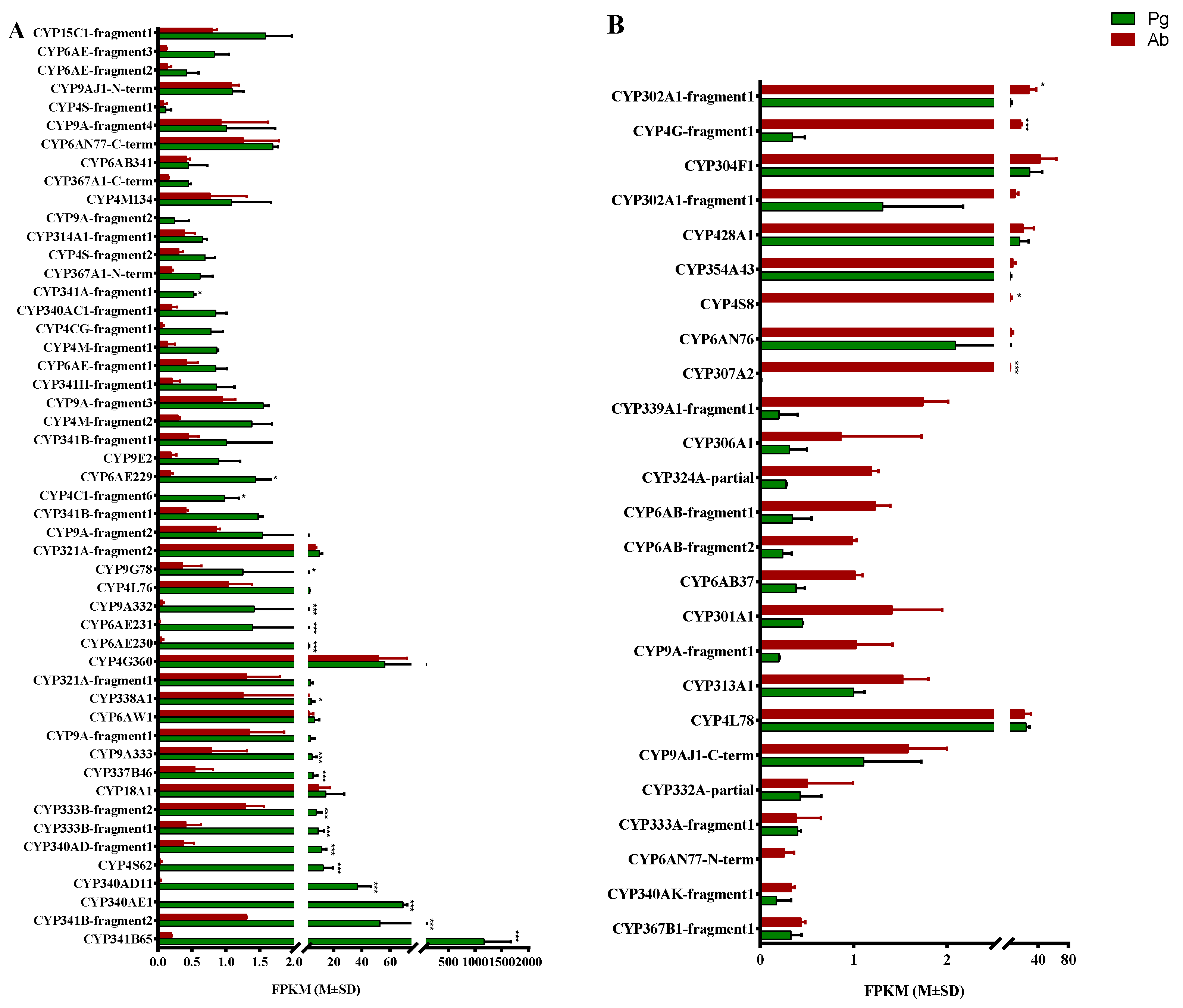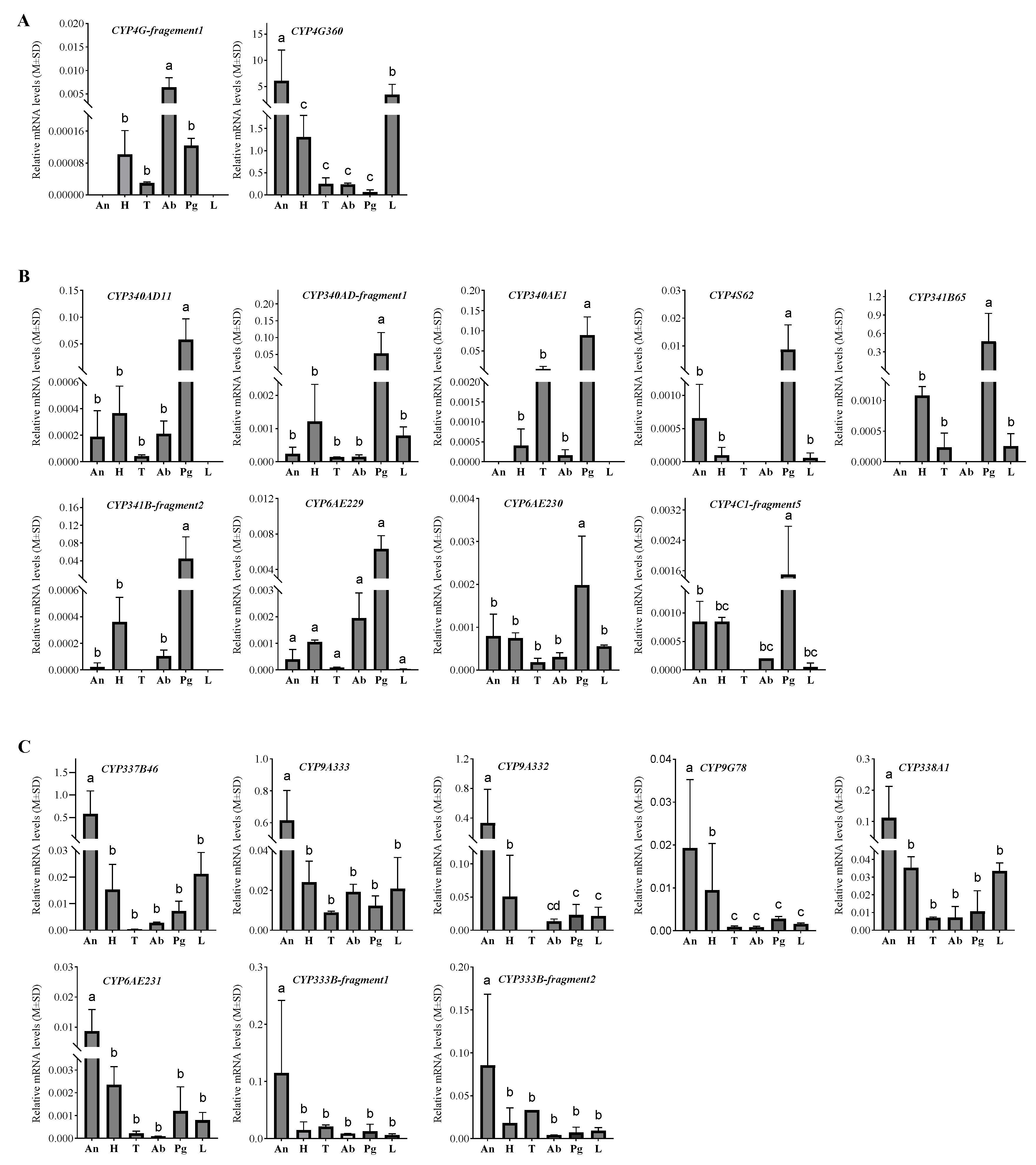Transcriptome-Wide Identification of Cytochrome P450s in Tea Black Tussock Moth (Dasychira baibarana) and Candidate Genes Involved in Type-II Sex Pheromone Biosynthesis
Abstract
Simple Summary
Abstract
1. Introduction
2. Results
2.1. Transcriptome Sequencing and Functional Annotation of Unigenes
2.2. Identification of Putative DbCYP Genes
2.3. Phylogenetic Analysis
2.4. Tissue Expression Profiles of Candidate P450s
3. Discussion
4. Materials and Methods
4.1. Insect Samples and Tissue Collection
4.2. cDNA Library Construction and Sequencing
4.3. De Novo Assembly and Annotation
4.4. Sequence Analysis and Phylogenetic Analysis
4.5. RT-qPCR Analysis
4.6. Statistics
5. Conclusions
Supplementary Materials
Author Contributions
Funding
Data Availability Statement
Acknowledgments
Conflicts of Interest
References
- Khrimian, A.; Lance, D.R.; Schwarz, M.; Leonhardt, B.A.; Mastro, V.C. Sex pheromone of browntail moth, Euproctis chrysorrhea (L.): Synthesis and field deployment. J. Agric. Food Chem. 2008, 56, 2452–2456. [Google Scholar] [CrossRef]
- Magsi, F.H.; Li, Z.; Cai, X.; Yamamoto, M.; Bian, L.; Zhao, Y.; Zhou, L.; Xiu, C.; Fu, N.; Ando, T.; et al. Identification of a unique three-component sex pheromone produced by the tea black tussock moth, Dasychira baibarana (Lepidoptera: Erebidae: Lymantriinae). Pest Manag. Sci. 2022, 78, 2607–2617. [Google Scholar] [CrossRef]
- Petkevicius, K.; Koutsoumpeli, E.; Betsi, P.C.; Ding, B.-J.; Kildegaard, K.R.; Jensen, H.; Mezo, N.; Mazziotta, A.; Gabrielsson, A.; Sinkwitz, C.; et al. Biotechnological production of the European corn borer sex pheromone in the yeast Yarrowia lipolytica. Biotechnol. J. 2021, 16, e2100004. [Google Scholar] [CrossRef]
- Löfstedt, C.; Xia, Y.-H. Biological production of insect pheromones in cell and plant factories. In Insect Pheromone Biochemistry and Molecular Biology, 2nd ed.; Blomquist, G.J., Vogt, R.G., Eds.; Academic Press: London, UK, 2021; pp. 89–121. [Google Scholar] [CrossRef]
- Petkevicius, K.; Löfstedt, C.; Borodina, I. Insect sex pheromone production in yeasts and plants. Curr. Opin. Biotechnol. 2020, 65, 259–267. [Google Scholar] [CrossRef]
- Ando, T.; Yamamoto, M. Semiochemicals containing lepidopteran sex pheromones: Wonderland for a natural product chemist. J. Pestic. Sci. 2020, 45, 191–205. [Google Scholar] [CrossRef] [PubMed]
- Goller, S.; Szöcs, G.; Francke, W.; Schulz, S. Biosynthesis of (3Z,6Z,9Z)-3,6,9-Octadecatriene: The Main Component of the Pheromone Blend of Erannis bajaria. J. Chem. Ecol. 2007, 33, 1505–1509. [Google Scholar] [CrossRef]
- Jurenka, R.A. Lepidoptera: Female sex pheromone biosynthesis and its hormonal regulation. In Insect Pheromone Biochemistry and Molecular Biology, 2nd ed.; Blomquist, G.J., Vogt, R.G., Eds.; Academic Press: London, UK, 2021; pp. 13–88. [Google Scholar] [CrossRef]
- Rong, Y.; Fujii, T.; Katsuma, S.; Yamamoto, M.; Ando, T.; Ishikawa, Y. CYP341B14: A cytochrome P450 involved in the specific epoxidation of pheromone precursors in the fall webworm Hyphantria cunea. Insect Biochem. Mol. Biol. 2014, 54, 122–128. [Google Scholar] [CrossRef] [PubMed]
- Grigoraki, L.; Grau-Bové, X.; Carrington Yates, H.; Lycett, G.J.; Ranson, H. Isolation and transcriptomic analysis of Anopheles gambiae oenocytes enables the delineation of hydrocarbon biosynthesis. eLife 2020, 9, e58019. [Google Scholar] [CrossRef] [PubMed]
- Qiu, Y.; Tittiger, C.; Wicker-Thomas, C.; Le Goff, G.; Young, S.; Wajnberg, E.; Fricaux, T.; Taquet, N.; Blomquist, G.J.; Feyereisen, R. An insect-specific P450 oxidative decarbonylase for cuticular hydrocarbon biosynthesis. Proc. Natl. Acad. Sci. USA 2012, 109, 14858–14863. [Google Scholar] [CrossRef] [PubMed]
- Rong, Y.; Fujii, T.; Naka, H.; Yamamoto, M.; Ishikawa, Y. Functional characterization of the epoxidase gene, Li_epo1 (CYP341B14), involved in generation of epoxyalkene pheromones in the mulberry tiger moth Lemyra imparilis. Insect Biochem. Mol. Biol. 2019, 107, 46–52. [Google Scholar] [CrossRef]
- Rong, Y.; Fujii, T.; Ishikawa, Y. CYPs in different families are involved in the divergent regio-specific epoxidation of alkenyl sex pheromone precursors in moths. Insect Biochem. Mol. Biol. 2019, 108, 9–15. [Google Scholar] [CrossRef]
- Greule, A.; Stok, J.E.; De Voss, J.J.; Cryle, M.J. Unrivalled diversity: The many roles and reactions of bacterial cytochromes P450 in secondary metabolism. Nat. Prod. Rep. 2018, 35, 757–791. [Google Scholar] [CrossRef]
- Berenbaum, M.R.; Bush, D.S.; Liao, L.H. Cytochrome P450-mediated mycotoxin metabolism by plant-feeding insects. Curr. Opin. Insect Sci. 2021, 43, 85–91. [Google Scholar] [CrossRef]
- Cui, S.F.; Wang, L.; Ma, L.; Geng, X.Q. P450-mediated detoxification of botanicals in insects. Phytoparasitica 2016, 44, 585–599. [Google Scholar] [CrossRef]
- Feyereisen, R. Insect P450 enzymes. Annu. Rev. Entomol. 1999, 44, 507–533. [Google Scholar] [CrossRef] [PubMed]
- Nauen, R.; Bass, C.; Feyereisen, R.; Vontas, J. The role of cytochrome p450s in insect toxicology and resistance. Annu. Rev. Entomol. 2022, 67, 105–124. [Google Scholar] [CrossRef] [PubMed]
- Qin, P.; Zheng, H.; Tao, Y.; Zhang, Y.; Chu, D. Genome-wide identification and expression analysis of the cytochrome P450 gene family in Bemisia tabaci MED and their roles in the insecticide resistance. Int. J. Mol. Sci. 2023, 24, 5899. [Google Scholar] [CrossRef] [PubMed]
- Niwa, R.; Niwa, Y.S. Enzymes for ecdysteroid biosynthesis: Their biological functions in insects and beyond. Biosci. Biotechnol. Biochem. 2014, 78, 1283–1292. [Google Scholar] [CrossRef] [PubMed]
- Guittard, E.; Blais, C.; Maria, A.; Parvy, J.-P.; Pasricha, S.; Lumb, C.; Lafont, R.; Daborn, P.J.; Dauphin-Villemant, C. CYP18A1, a key enzyme of Drosophila steroid hormone inactivation, is essential for metamorphosis. Dev. Biol. 2011, 349, 35–45. [Google Scholar] [CrossRef] [PubMed]
- Blomquist, G.J.; Tittiger, C.; MacLean, M.; Keeling, C.I. Cytochromes P450: Terpene detoxification and pheromone production in bark beetles. Curr. Opin. Insect Sci. 2021, 43, 97–102. [Google Scholar] [CrossRef] [PubMed]
- Feng, B.; Zheng, K.; Li, C.; Guo, Q.; Du, Y. A cytochrome P450 gene plays a role in the recognition of sex pheromones in the tobacco cutworm, Spodoptera litura. Insect Mol. Biol. 2017, 26, 369–382. [Google Scholar] [CrossRef] [PubMed]
- Holze, H.; Schrader, L.; Buellesbach, J. Advances in deciphering the genetic basis of insect cuticular hydrocarbon biosynthesis and variation. Heredity 2021, 126, 219–234. [Google Scholar] [CrossRef] [PubMed]
- Feyereisen, R. Origin and evolution of the CYP4G subfamily in insects, cytochrome P450 enzymes involved in cuticular hydrocarbon synthesis. Mol. Phylogenetics Evol. 2020, 143, 106695. [Google Scholar] [CrossRef]
- Cruz, O.G. A Novel Role for Cytochrome P450 G 35 (CYP4G35) in Odor Processing in Aedes Aegypti Mosquitoes. Master’s Thesis, University of Nevada, Reno, NV, USA, 2023. Available online: https://scholarworks.unr.edu/bitstream/handle/11714/8485/GarciaCruz_unr_0139M_14020.pdf?sequence=1 (accessed on 9 February 2024).
- Kefi, M.; Balabanidou, V.; Douris, V.; Lycett, G.; Feyereisen, R.; Vontas, J. Two functionally distinct CYP4G genes of Anopheles gambiae contribute to cuticular hydrocarbon biosynthesis. Insect Biochem. Mol. Biol. 2019, 110, 52–59. [Google Scholar] [CrossRef] [PubMed]
- MacLean, M.; Nadeau, J.; Gurnea, T.; Tittiger, C.; Blomquist, G.J. Mountain pine beetle (Dendroctonus ponderosae) CYP4Gs convert long and short chain alcohols and aldehydes to hydrocarbons. Insect Biochem. Mol. Biol. 2018, 102, 11–20. [Google Scholar] [CrossRef]
- Kiyota, R.; Arakawa, M.; Yamakawa, R.; Yasmin, A.; Ando, T. Biosynthetic pathways of the sex pheromone components and substrate selectivity of the oxidation enzymes working in pheromone glands of the fall webworm, Hyphantria cunea. Insect Biochem. Mol. Biol. 2011, 41, 362–369. [Google Scholar] [CrossRef] [PubMed]
- Zhang, Y.-N.; Zhu, X.-Y.; Fang, L.-P.; He, P.; Wang, Z.-Q.; Chen, G.; Sun, L.; Ye, Z.-F.; Deng, D.-G.; Li, J.-B. Identification and expression profiles of sex pheromone biosynthesis and transport related genes in Spodoptera litura. PLoS ONE 2015, 10, e0140019. [Google Scholar] [CrossRef]
- Kumar, S.; Stecher, G.; Tamura, K. MEGA7: Molecular evolutionary genetics analysis version 7.0 for bigger datasets. Mol. Biol. Evol. 2016, 33, 1870–1874. [Google Scholar] [CrossRef]
- Bustin, S.; Vandesompele, J. Standardization of qPCR and RT-qPCR. Genet. Eng. Biotechnol. News 2009, 29, 40–43. [Google Scholar]
- Livak, K.J.; Schmittgen, T.D. Analysis of relative gene expression data using real-time quantitative PCR and the 2(-Delta Delta C(T)) method. Methods 2001, 25, 402–408. [Google Scholar] [CrossRef]





| Statistics | Data |
|---|---|
| Total unigenes number | 34,468 |
| Total unigenes length | 39,402,381 |
| Total transcripts number | 59,396 |
| Total transcript length | 82,599,491 |
| Average length | 1143 |
| Largest unigene | 30,524 |
| NR-Annotated unigenes | 15,219 |
| GO-Annotated unigenes | 7107 |
| COG-Annotated unigenes | 11,624 |
| KEGG-Annotated unigenes | 7465 |
| SWSS-Annotated unigenes | 8941 |
| P450 Clan | CYP2 | CYP3 | CYP4 | Mitochondrial |
|---|---|---|---|---|
| Total number | 5 | 33 | 28 | 9 |
| Family | 5 | 8 | 5 | 6 |
| Subfamily | 5 | 13 | 16 | 6 |
Disclaimer/Publisher’s Note: The statements, opinions and data contained in all publications are solely those of the individual author(s) and contributor(s) and not of MDPI and/or the editor(s). MDPI and/or the editor(s) disclaim responsibility for any injury to people or property resulting from any ideas, methods, instructions or products referred to in the content. |
© 2024 by the authors. Licensee MDPI, Basel, Switzerland. This article is an open access article distributed under the terms and conditions of the Creative Commons Attribution (CC BY) license (https://creativecommons.org/licenses/by/4.0/).
Share and Cite
Wang, T.; Liu, X.; Luo, Z.; Cai, X.; Li, Z.; Bian, L.; Xiu, C.; Chen, Z.; Li, Q.; Fu, N. Transcriptome-Wide Identification of Cytochrome P450s in Tea Black Tussock Moth (Dasychira baibarana) and Candidate Genes Involved in Type-II Sex Pheromone Biosynthesis. Insects 2024, 15, 139. https://doi.org/10.3390/insects15020139
Wang T, Liu X, Luo Z, Cai X, Li Z, Bian L, Xiu C, Chen Z, Li Q, Fu N. Transcriptome-Wide Identification of Cytochrome P450s in Tea Black Tussock Moth (Dasychira baibarana) and Candidate Genes Involved in Type-II Sex Pheromone Biosynthesis. Insects. 2024; 15(2):139. https://doi.org/10.3390/insects15020139
Chicago/Turabian StyleWang, Tiekuang, Xufei Liu, Zongxiu Luo, Xiaoming Cai, Zhaoqun Li, Lei Bian, Chunli Xiu, Zongmao Chen, Qiurong Li, and Nanxia Fu. 2024. "Transcriptome-Wide Identification of Cytochrome P450s in Tea Black Tussock Moth (Dasychira baibarana) and Candidate Genes Involved in Type-II Sex Pheromone Biosynthesis" Insects 15, no. 2: 139. https://doi.org/10.3390/insects15020139
APA StyleWang, T., Liu, X., Luo, Z., Cai, X., Li, Z., Bian, L., Xiu, C., Chen, Z., Li, Q., & Fu, N. (2024). Transcriptome-Wide Identification of Cytochrome P450s in Tea Black Tussock Moth (Dasychira baibarana) and Candidate Genes Involved in Type-II Sex Pheromone Biosynthesis. Insects, 15(2), 139. https://doi.org/10.3390/insects15020139





